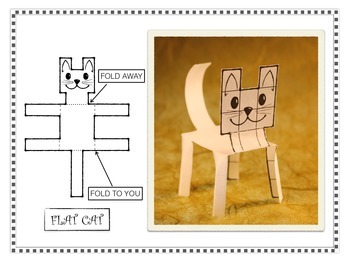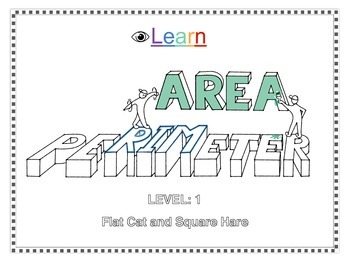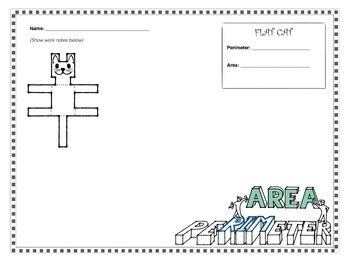Area and Perimeter Math - Art Activities (Digital & Printable Worksheets)
76,850 Downloads
eyeLEARN
642 Followers
Grade Levels
K - 7th, Homeschool
Subjects
Resource Type
Formats Included
- PDF
Pages
9+
eyeLEARN
642 Followers
Description
Flat Cat and Square Hare are only two of the characters you will find in my booklet on Area and Perimeter. They are the first, and simplest, of the creations and are meant teach the concepts of area and perimeter by filling a space with squares, (just as our ancestors did). The booklet illustrates increasingly more sophisticated shapes that in turn, demonstrate the need for more and more advanced math classes. It is my hope that teachers will have the complete book on hand in the classroom so that they can show young students where they are headed, (and older student can reflect back on where they have been.
Well, enough of that. If you’re interested you can read about the rationale for the complete booklet below. I hope you and your students will have fun building Flat Cat and Square Hare and in the process perhaps they will learn a thing or two.
Materials:
Scissors
Card stock paper-white preferably (Note: the templates work best if you print them directly onto thicker paper. However, you can print to regular paper and glue it onto thicker paper. You can also just make these using regular paper. These will not be quite as durable.
Optional: colored pencils, crayons, markers for coloring creations
Rationale for the Complete Booklet:
Here’s an ingenious and ‘seriously → fun’ way to learn about area & perimeter, (and much more). This activity booklet will provide your students with a clever progression of beautifully designed paper geometric creations that will provide hours of student inquiry, and deep understanding of a number of important math concepts. And yes, you can use this activity book equally well in a kindergarten class or in a calculus class.
Here’s how this works, starting at Level 1 students cut out and fold figures into geometric creatures like ‘Flat Cat’ & ‘Square Hare’. At Level 1, the figures are divided into squares so students can find the area and perimeter by adding up the number of squares total, (area), and the number of square sides along the edge, (perimeter).
Note: If you’re a teacher K-2 you’re already thinking this is too hard – and for most kids this age you are right! However, I believe there is tremendous value in having students working with math concepts in their hands, so to speak, well before they work with them in their heads. (Personally I know the hours I spent building stuff as a young boy helped me earn my physics degree years later. Students in early elementary can recognize the shapes used and count them. They also might be inspired to create their own creations using geometric shapes.
Note: If you’re an advanced math teacher you’re thinking, this is too easy . But, please read on…
Right from the get-go, students will see that a ‘cat’ cannot be accurately represented using only squares just as our early ancestors did many, many years ago. However, you can get a decent estimate using just squares. More interesting shapes can be constructed using triangles, Level 4, but this does require some ‘hidden knowledge’ about triangles and the use of a ruler to find the perimeter. (Or you might apply the Pythagorean theorem depending on the age and level of your students.)
Next we move on to circles, Level 5, which of course requires a ‘secret’ formula and again the use of a ruler to measure the diameter, (again another important historical development – right? See where I’m going?)
Finally, students will be presented with shapes whose area and perimeter can only be calculated using advanced math – basically Calculus. It is NOT important that the elementary school teacher know how to calculate the area of these shapes using calculus! It is important, however, for teachers and students to understand the ‘end result’ of math in its continuum. (Calculus was one of the most exciting discoveries in math because it allows you to find the area and perimeter of nearly any shape. That allows us to build airplanes and send people to the moon! However, the basis of calculus is really exactly what students do to find the area of ‘Flat Cat’ – add up squares! But really, really small ones.)
So you see, this booklet provides a visual presentation of the math continuum that parallels, pretty closely, historical discoveries. Students, and teachers can see where the study of math might take them; also why more challenging classes in mathematics are needed.
What you get:
35 pages plus some (total in complete booklet)
Level 1 (Contains Whole or Half Squares)
Flat Cat and Square Hare (with grid)
Flat Cat and Square Hare (no grid)
Area and Perimeter Summary Sheets
Level 1/2 (Contains Squares; Optional: can be used for higher level discussions such as symmetry)
Several Student cover sheets
Photo of final creation, (to help with construction)
Ulam – The Dizzy Snake (Clockwise Spiral, with grid)
Malu – The Dizzy Snake (Counter Clockwise Spiral, with grid)
Ulam and Malu – The Dizzy Snake (Both Spirals, no grid)
Area and Perimeter Summary Sheet
Dizzy ‘Discovery Notes’ (for advanced students – Differentiated learning)
Discovery Journal (Template for teacher personalization)
Level 2: (Contains Squares & Fractions of Squares)
Archie the Dog (with grid)
Archie the Dog (no grid)
Area and Perimeter Summary Sheet
Archie ‘Discovery Notes’
Level 1-3 (Contains squares only but potential for experimentation – optional)
Whirly Bird Helicopter (with grid)
Whirly Bird Helicopter (no grid)
Whirly Bird ‘Discovery Notes’
Level 3: (Contains Squares, Fractions of Squares, & Cut-a-ways)
Graph Giraffe and Linear Llama (with grid)
Graph Giraffe and Linear Llama (no grid)
Area & Perimeter Summary Sheet
Level 1-4: (Contains only squares but may evoke deep questions about definitions)
Mobius Loop Template
Area and Perimeter Summary Sheet
Mobius loop ‘Discovery Notes’
Level 4: (Triangles)
Heron the Crocodile (with grid)
Heron the Crocodile (no grid)
Area and Perimeter Summary Sheet
Heron ‘Discovery Notes’
Level 5: (Circles)
Biblio-Birds [4 templates]
Area and Perimeter Summary Sheet
Slinky Snake (with design)
Slinky Snake (you design)
Area and Perimeter Summary Sheet
Level 6: (Parabolas)
3- Mini Boomerangs
(Turning Tern, Newton, & Leibniz)
Graphing workings
Area Calculations Summary Sheet
Launch Directions for Mini Boomerang
This unit activity meets or exceeds 21st Century and STEM learning expectations, and Common Core learning outcomes. (I think STEM, which stands for science, technology, engineering and math, should be changed to STEAM, where 'A' stands for Art. What do you think?)
Well, enough of that. If you’re interested you can read about the rationale for the complete booklet below. I hope you and your students will have fun building Flat Cat and Square Hare and in the process perhaps they will learn a thing or two.
Materials:
Scissors
Card stock paper-white preferably (Note: the templates work best if you print them directly onto thicker paper. However, you can print to regular paper and glue it onto thicker paper. You can also just make these using regular paper. These will not be quite as durable.
Optional: colored pencils, crayons, markers for coloring creations
Rationale for the Complete Booklet:
Here’s an ingenious and ‘seriously → fun’ way to learn about area & perimeter, (and much more). This activity booklet will provide your students with a clever progression of beautifully designed paper geometric creations that will provide hours of student inquiry, and deep understanding of a number of important math concepts. And yes, you can use this activity book equally well in a kindergarten class or in a calculus class.
Here’s how this works, starting at Level 1 students cut out and fold figures into geometric creatures like ‘Flat Cat’ & ‘Square Hare’. At Level 1, the figures are divided into squares so students can find the area and perimeter by adding up the number of squares total, (area), and the number of square sides along the edge, (perimeter).
Note: If you’re a teacher K-2 you’re already thinking this is too hard – and for most kids this age you are right! However, I believe there is tremendous value in having students working with math concepts in their hands, so to speak, well before they work with them in their heads. (Personally I know the hours I spent building stuff as a young boy helped me earn my physics degree years later. Students in early elementary can recognize the shapes used and count them. They also might be inspired to create their own creations using geometric shapes.
Note: If you’re an advanced math teacher you’re thinking, this is too easy . But, please read on…
Right from the get-go, students will see that a ‘cat’ cannot be accurately represented using only squares just as our early ancestors did many, many years ago. However, you can get a decent estimate using just squares. More interesting shapes can be constructed using triangles, Level 4, but this does require some ‘hidden knowledge’ about triangles and the use of a ruler to find the perimeter. (Or you might apply the Pythagorean theorem depending on the age and level of your students.)
Next we move on to circles, Level 5, which of course requires a ‘secret’ formula and again the use of a ruler to measure the diameter, (again another important historical development – right? See where I’m going?)
Finally, students will be presented with shapes whose area and perimeter can only be calculated using advanced math – basically Calculus. It is NOT important that the elementary school teacher know how to calculate the area of these shapes using calculus! It is important, however, for teachers and students to understand the ‘end result’ of math in its continuum. (Calculus was one of the most exciting discoveries in math because it allows you to find the area and perimeter of nearly any shape. That allows us to build airplanes and send people to the moon! However, the basis of calculus is really exactly what students do to find the area of ‘Flat Cat’ – add up squares! But really, really small ones.)
So you see, this booklet provides a visual presentation of the math continuum that parallels, pretty closely, historical discoveries. Students, and teachers can see where the study of math might take them; also why more challenging classes in mathematics are needed.
What you get:
35 pages plus some (total in complete booklet)
Level 1 (Contains Whole or Half Squares)
Flat Cat and Square Hare (with grid)
Flat Cat and Square Hare (no grid)
Area and Perimeter Summary Sheets
Level 1/2 (Contains Squares; Optional: can be used for higher level discussions such as symmetry)
Several Student cover sheets
Photo of final creation, (to help with construction)
Ulam – The Dizzy Snake (Clockwise Spiral, with grid)
Malu – The Dizzy Snake (Counter Clockwise Spiral, with grid)
Ulam and Malu – The Dizzy Snake (Both Spirals, no grid)
Area and Perimeter Summary Sheet
Dizzy ‘Discovery Notes’ (for advanced students – Differentiated learning)
Discovery Journal (Template for teacher personalization)
Level 2: (Contains Squares & Fractions of Squares)
Archie the Dog (with grid)
Archie the Dog (no grid)
Area and Perimeter Summary Sheet
Archie ‘Discovery Notes’
Level 1-3 (Contains squares only but potential for experimentation – optional)
Whirly Bird Helicopter (with grid)
Whirly Bird Helicopter (no grid)
Whirly Bird ‘Discovery Notes’
Level 3: (Contains Squares, Fractions of Squares, & Cut-a-ways)
Graph Giraffe and Linear Llama (with grid)
Graph Giraffe and Linear Llama (no grid)
Area & Perimeter Summary Sheet
Level 1-4: (Contains only squares but may evoke deep questions about definitions)
Mobius Loop Template
Area and Perimeter Summary Sheet
Mobius loop ‘Discovery Notes’
Level 4: (Triangles)
Heron the Crocodile (with grid)
Heron the Crocodile (no grid)
Area and Perimeter Summary Sheet
Heron ‘Discovery Notes’
Level 5: (Circles)
Biblio-Birds [4 templates]
Area and Perimeter Summary Sheet
Slinky Snake (with design)
Slinky Snake (you design)
Area and Perimeter Summary Sheet
Level 6: (Parabolas)
3- Mini Boomerangs
(Turning Tern, Newton, & Leibniz)
Graphing workings
Area Calculations Summary Sheet
Launch Directions for Mini Boomerang
This unit activity meets or exceeds 21st Century and STEM learning expectations, and Common Core learning outcomes. (I think STEM, which stands for science, technology, engineering and math, should be changed to STEAM, where 'A' stands for Art. What do you think?)
Total Pages
9+
Answer Key
N/A
Teaching Duration
1 hour
Report this resource to TPT
Reported resources will be reviewed by our team. Report this resource to let us know if this resource violates TPT’s content guidelines.





